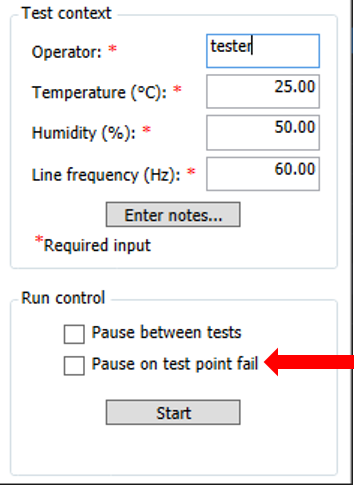Receiver Compression Performance Test Overview
|

|
-
A separate test has been created for frequencies above 50 GHz
to avoid unnecessary recalibration of the power sensors.
-
Models with LFE options and PNA-L models N5231A/AS/B, N5232A/AS/B, N5239A/AS/B will also run the Receiver Compression at Low Frequency.
-
Because of the measurement process, "Source Unleveled"
messages may appear on the PNA display during this test. These errors are expected and
acceptable.
-
Prior to running this test, certain settings must be set on the PNA to avoid error messages and possible test failure. Refer to Receiver Compression Troubleshooting for more information.
-
Be sure that  Pause on test point fail is not selected for this test. Pause on test point fail is not selected for this test.

|
Test Description
This test measures the compression at the specified
maximum power level for the receivers, and verifies the Test Port Input – Maximum Test Port Input Level specification, or the Test Port Input – Receiver Compression specification, whichever applies. Compression is measured at various
frequencies across the range of the PNA. The test is performed separately on each port, and measures amplitude
distortion at the maximum input power level for a given receiver.
A negative test result indicates compression while a positive
result indicates amplitude expansion.
The test process measures two power deltas, one at
the top of the receiver input power range and another in the middle of
the input power range. The difference between the two deltas represents
the compression at the top of the power range. The PNA provides the signal used to test each port.
A cable is used to allow a
separate port to drive the port under test. Some PNA models require a
Gain Compression Test Set to boost the PNA output to the
level required for testing. Some models may require multiple test processes: one for the lower frequency range and another for the upper frequency range.
For troubleshooting help, see Receiver Compression Troubleshooting.
Equipment and Connection Setups
Equipment and connection setups will differ depending on the test plan variant selected: Factory Recommended Variant or Normal Variant. For more information about test plan variants, refer to Test Plan Variants topic.
For a list of required equipment and connection setup illustrations, go to the topic page that matches the test plan variant selected:

 Pause on test point fail is not selected for this test.
Pause on test point fail is not selected for this test.